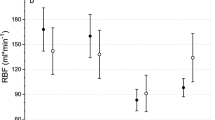Abstract
The cardiovascular responses to an infusion of KRN2391, a potassium channel opener, was studied in halothane-anesthetized dogs. Intravenous administration of KRN2391 at 1.0 and 5.0 μg·kg−1·min−1 for 60 min produced dose-dependent decreases in mean arterial pressure (MAP) and systemic vascular resistance (SVR) associated with dose-dependent increases in the cardiac index (CI) and stroke volume index (SVI) but was not accompanied by an increase in heart rate (HR). The maximum decrease in MAP during the infusion of KRN2391 at 1.0 and 5.0 μg·kg−1·min−1 was −13±7% (P<0.01) and −37±10% (P<0.01), respectively. The maximum reduction in SVR after 1.0 and 5.0 μg·kg−1·min−1 was −20±11% (P<0.01) and −60±16% (P<0.01), respectively. A KRN2391 infusion of 1.0 and 5.0 μg·kg−1·min−1 increased Cl a maximum of 11±13% (P<0.05) and 65±33% (P<0.01), respectively. KRN2391 1.0 μg·kg−1·min−1 showed a tendency to increase SVI but this change was not significant, KRN2391 5.0 μg·kg−1·min−1, however, produced a significant increase in SVI. The present results demonstrate that the decrease in MAP and the increases in CI and SVI caused by KRN2391 are due to a reduction in the afterload. Therefore, we conclude that these cardiovascular profiles of KRN2391 may be benificial in perioperative uses including the control of systemic blood pressure and the treatment of hypertension during halothane anesthesia in clinical practice.
Similar content being viewed by others
References
Turlapaty P, Vary R, Kaplan JA (1989) Nicardipine, a new intravenous calcium antagonist: a review of its pharmacology, pharmacokinetics, and perioperative applications. J Cardiothorac Anesth 3:344–355
Kashiwabara T, Nakajima S, Izawa T, Fukushima H, Nishikori K (1991) Characteristics of KRN2391, a novel vasodilator, compared with those of cromakalim, pinacidil and nifedipine in rat aorta. Eur J Pharmacol 196:1–7
Ogawa N, Jinno Y, Kaneta S, Harada H, Fukata Y, Fukushima H (1993) Hemodynamic profile of KRN2391, a novel vasodilator, in anesthetized dogs. J Cardiovasc Pharmacol 21:874–882
Ogawa N, Kaneta S, Jinno Y, Kasai H, Nishikori K, Fukushima H (1992) Comparative cardiovascular effects of KRN2391 and other coronary vasodilators in anesthetized open-chest dogs. Arch Int Pharmacodyn Ther 318:36–46
Buljubasic N, Rusch NJ, Marijic J, Kampine JP, Bosnjak ZJ (1992) Effects of halothane and isoflurane on calcium and potassium channel currents in canine coronary arterial cells. Anesthesiology 76:990–998
Kaneta S, Jinno Y, Harada K, Ohta H, Ogawa N, Nishikori K (1990) Cardiohaemodynamic effect of KRN2391, a novel vasodilator, in anesthetized dogs. Jpn J Pharmacol 52 [Suppl 1]:314
Biscoe TJ, Miller RA (1964) The effect of halothane on carotid sinus baroreceptor activity. J Physiol (Lond) 173:24–37
Price HL, Price ML, Morse HT (1965) Effects of cyclopropane, halothane and procaine on the vasomotor “center” of the dog. Anesthesiology 26:55–60
Seagard IL, Hopp FA, Donegan JH, Kalbfleisch JH, Kampine JP (1982) Halothane and the carotid sinus reflex: evidence for multiple sites of action. Anesthesiology 57:191–202
Lynch C III, Vogel S, Sperelakis N (1981) Halothane depression of myocardial slow action potentials. Anesthesiology 55:360–368
Jinno Y, Kaneta S, Ohta H, Fukushima H, Izawa T, Ogawa N (1993) Inotropic and chronotropic effects of KRN2391, a novel vasodilator, on isolated guinea-pig atria. Asia Pacific J Pharmacol 8:23–27
Todd MM, Morris PJ, Moss J, Philbin DM (1982) Hemodynamic consequences of abrupt withdrawal of nitroprusside or nitroglycerin following induced hypotension. Anesth Analg 61:261–266
Gotanda K, Yokoyama H, Satoh K, Taira N (1989) Cardiohemodynamic effects of cromakalim and pinacidil, potassiumchannel openers, in the dog, special reference to venous return. Cardiovasc Drugs Ther 3:507–515
Kokubun M, Taira N, Hashimoto K (1974) Cardiohemodynamic effects of nitroglycerin and several vasodilators. Jpn Heart J 15:126–144
Sakai K, Shiraki Y, Nabata H (1981) Cardiovascular effects of a new coronary vasodilator N-(2-hydroxyethyl)nicotinamide nitrate (SG-75): comparison with nitroglycerin and diltiazem. J Cardiovasc Pharmacol 3:139–150
Leier CV, Huss P, Magorien RD, Unverferth DV (1983) Improved exercise capacity and differing arterial and venous tolerance during chronic isosorbide dinitrate therapy for congestive heart failure. Circulation 67:817–822
Sutton SC, Fung H-L (1983) Effect of dosage regimen on the development of tolerance to nitroglycerin in rats. J Cardiovasc Pharmacol 5:1086–1092
Unger P, Leone A, Degre S, Berkenboom G (1991) Tolerance to intravenous nitrates. J Cardiovasc Pharmacol 17 [Suppl 3]:S300-S303
Kaneta S, Jinno Y, Harada K, Fukushima H, Ogawa N (1992) Tolerance to the increase in coronary blood flow induced by KRN2391. Arch Int Pharmacodyn Ther 318:21–35
Khambatta HJ, Stone JG, Khan E (1979) Hypertension during anesthesia on discontinuation of sodium nitroprusside-induced hypotension. Anesthesiology 51:127–130
Packer M, Meller J, Medina N, Gorlin R, Herman MV (1979) Rebound hemodynamic events after the abrupt withdrawal of nitroprusside in patients with severe chronic heart failure. N Engl J Med 301:1193–1197
Kapur PA, Bloor BC, Flacke WE, Olewein SK (1984) Comparison of cardiovascular responses to verapamil during enflurane, isoflurane, or halothane anesthesia in the dog. Anesthesiology 61:156–160
Hysing ES, Chelly JE, Doursout M-F, Hartley C, Merin RG (1986) Cardiovascular effects of and interaction between calcium blocking drugs and anesthetics in chronically instrumented dogs. III. nicardipine and isoflurane. Anesthesiology 65:385–391
Author information
Authors and Affiliations
About this article
Cite this article
Takeda, S., Inada, Y., Ozawa, Y. et al. Hemodynamic effects of KRN2391 (potassium channel opener) in halothane-anesthetized dogs. J Anesth 9, 176–181 (1995). https://doi.org/10.1007/BF02479852
Received:
Accepted:
Issue Date:
DOI: https://doi.org/10.1007/BF02479852




